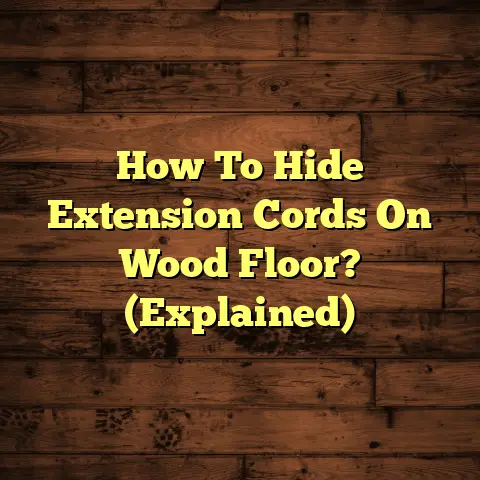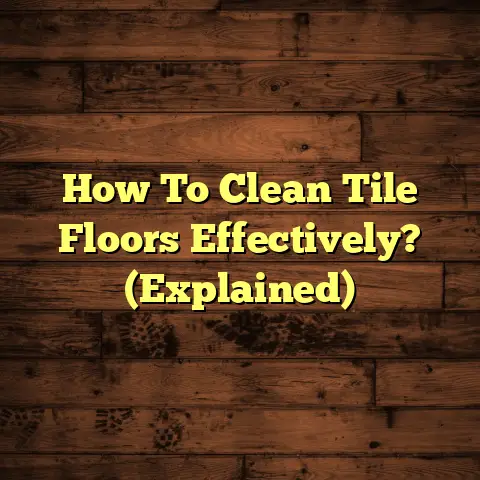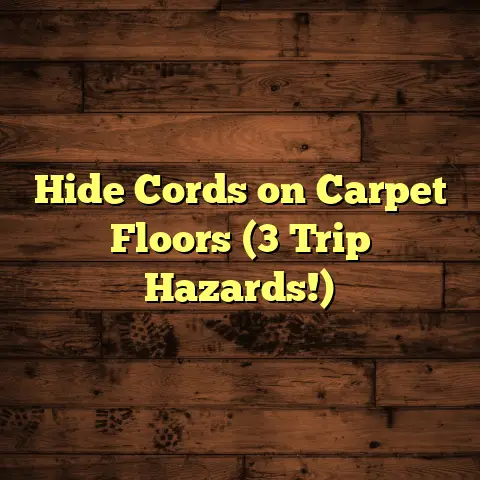Nail Gun on Hardwood? (3 Dangers Pro Installers Know!)
Alright, let’s talk hardwood floors! I’ve seen it all in my years as a flooring contractor. And I’m going to tell you a story.
Picture this: a buddy of mine, let’s call him Dave, decides he’s going to become a DIY flooring guru. He watched a couple of YouTube videos, bought a shiny new nail gun, and thought he was ready to transform his living room.
Fast forward a weekend later, and Dave’s calling me, practically in tears. The floor looked like it had been attacked by a woodpecker, nails were sticking out, and some boards were split right down the middle.
The moral of the story? Nail guns and hardwood can be a match made in heaven, but they can also be a recipe for disaster if you don’t know what you’re doing.
Let’s dive into the 3 dangers that us pro installers know like the back of our hands. Trust me, understanding these can save you a ton of headaches (and money) down the line.
1. The Allure of Nail Guns in Hardwood Flooring
Understanding Nail Guns
So, what exactly is a nail gun? Simply put, it’s a power tool that drives nails into wood (or other materials) with speed and precision. There are different types, like pneumatic (air-powered) and cordless (battery-powered), each with its own pros and cons.
For hardwood flooring, you’ll typically see us pros using flooring nailers or staplers. These are specifically designed to install tongue-and-groove flooring properly. They ensure the nails or staples are driven at the correct angle through the tongue of the board, concealing them from view.
Why Use a Nail Gun for Hardwood?
Why bother with a nail gun when you could just use a hammer and nails? Well, let me tell you, speed is the name of the game. A nail gun lets you install flooring way faster than doing it by hand. It’s also more consistent, ensuring each nail is driven to the same depth.
For DIYers, the appeal is obvious: you can tackle a flooring project in a weekend instead of a week. For professionals like myself, it’s about efficiency and getting the job done right, the first time, every time.
Transition to Dangers
But here’s the thing: nail guns are powerful tools, and with great power comes great responsibility (as Spider-Man would say!). Using a nail gun on hardwood without proper knowledge can lead to some serious problems.
I’m talking about misfires that damage your flooring, nails that are driven too deep (or not deep enough), and damage to that beautiful finish you paid good money for.
So, let’s get into the nitty-gritty of those 3 dangers that professional installers are always keeping an eye on.
2. Danger #1 – Misfires and Their Consequences
Explaining Misfires
A misfire is when the nail gun doesn’t drive the nail properly, or at all. It might bend the nail, only partially drive it in, or even shoot it out at a weird angle. Misfires are frustrating, time-consuming, and can be downright dangerous.
What causes misfires during hardwood installation? There are a few culprits:
- Incorrect Nail Size: Using the wrong size or type of nail for your nail gun and flooring can cause jams and misfires.
- Incorrect Air Pressure: If you’re using a pneumatic nail gun, the air pressure needs to be just right. Too low, and the nail won’t drive properly. Too high, and you risk damaging the wood.
- Dirty or Damaged Nail Gun: A nail gun that’s not properly maintained can malfunction and cause misfires.
- Knots in the Wood: Hardwood with knots can deflect the nail, causing it to bend or misfire.
Impacts on Flooring
Misfires can wreak havoc on your hardwood flooring. Imagine this: you’re happily nailing away, and suddenly the nail bends over and gouges the surface of your brand-new plank. Ouch!
Misfires can lead to:
- Surface Damage: Scratches, dents, and gouges on the surface of your flooring.
- Split Wood: A misfired nail can split the end of a plank, making it unusable.
- Weakened Installation: If a nail is only partially driven, it won’t hold the flooring securely, leading to loose boards and squeaks down the road.
I remember one job where a DIYer used a framing nailer (which is designed for construction, not flooring) on his hardwood. The result? A complete disaster. The nails were way too big, causing the wood to split and splinter. He ended up having to replace half of the flooring!
Safety Risks
Misfires aren’t just bad for your flooring; they can also be dangerous for you and anyone else nearby. A misfired nail can become a projectile, shooting out at high speed.
According to the CDC, nail gun injuries send approximately 37,000 people to emergency rooms each year in the United States. While not all of these are related to flooring, it highlights the potential for serious injury.
Here are some safety risks associated with misfires:
- Eye Injuries: A flying nail can cause serious eye damage.
- Lacerations: A misfired nail can cut or puncture skin.
- Bruises: Being struck by a misfired nail can cause painful bruises.
Always wear safety glasses when operating a nail gun, and make sure anyone nearby is also wearing eye protection. It’s also a good idea to wear gloves to protect your hands.
3. Danger #2 – Under- or Over-Penetration
Understanding Penetration Depth
Getting the nail penetration depth just right is crucial for a successful hardwood flooring installation. If the nail is driven too deep (over-penetration) or not deep enough (under-penetration), you’re going to have problems.
The ideal penetration depth depends on the type of wood, the thickness of the flooring, and the type of nail gun you’re using. Generally, you want the nail to be driven deep enough to securely hold the flooring in place, but not so deep that it damages the wood or interferes with the subfloor.
Consequences of Improper Penetration
Under-penetration is when the nail doesn’t go in far enough. This can happen if the air pressure is too low, the nail gun is set incorrectly, or you’re trying to nail through a particularly hard piece of wood.
The consequences of under-penetration include:
- Loose Floorboards: The flooring won’t be securely attached to the subfloor, leading to movement and shifting.
- Squeaks: Loose floorboards rubbing against each other will create annoying squeaks every time you walk on them.
- Tripping Hazards: If the flooring is significantly loose, it can create a tripping hazard.
Over-penetration, on the other hand, is when the nail is driven too deep. This can happen if the air pressure is too high, the nail gun is set incorrectly, or you’re using too much force.
The consequences of over-penetration include:
- Split Wood: The force of the nail can split the wood, weakening the integrity of the floor.
- Damaged Subfloor: The nail can penetrate through the flooring and into the subfloor, potentially damaging it.
- Reduced Holding Power: Believe it or not, over- penetration can actually reduce the holding power of the nail. The nail can bend or distort, making it less effective at securing the flooring.
Professional Insights
I asked my buddy Mark, another seasoned flooring installer, about his experiences with penetration issues. He said, “I’ve seen it all, man. Guys cranking up the air pressure to the max thinking it’ll make the job go faster, and then wondering why their flooring is splitting. It’s all about finding that sweet spot.”
Mark also emphasized the importance of testing the nail gun on a scrap piece of flooring before starting the actual installation. “Always test your settings! You want to make sure the nails are going in just right. A little bit of testing can save you a whole lot of trouble later on.”
We mitigate these dangers by:
- Adjusting Air Pressure: Carefully adjusting the air pressure on pneumatic nail guns to match the type of flooring being installed.
- Using Depth Adjustment Settings: Utilizing the depth adjustment settings on the nail gun to control how far the nails are driven.
- Regularly Checking Penetration: Periodically checking the penetration depth to ensure consistency throughout the installation.
- Using the Right Nailer: Ensuring the nailer being used is designed for the specific type of flooring being installed.
4. Danger #3 – Damage to the Hardwood Finish
Impact of Nail Guns on Finish
Even if you manage to avoid misfires and get the penetration depth just right, there’s still another danger to be aware of: damage to the hardwood finish.
Nail guns can inadvertently damage the finish of your hardwood floors in a number of ways:
- Scratches: The nose of the nail gun can scratch the finish if it’s not held flush against the flooring.
- Dents: If the nail gun is applied with too much force, it can dent the finish.
- Marks: The rubber or plastic tip on the nail gun can leave marks on the finish if it’s dirty or worn.
Long-term Effects
A damaged finish can have a significant impact on the aesthetic appeal and resale value of your hardwood floors. Scratches, dents, and marks can make your floors look worn and neglected.
Over time, damaged finishes can also become more susceptible to dirt and moisture, leading to further deterioration. This can result in:
- Fading: Damaged finishes can fade more quickly when exposed to sunlight.
- Staining: Dirt and spills can penetrate damaged finishes, causing unsightly stains.
- Peeling: In severe cases, damaged finishes can peel or flake off, exposing the bare wood underneath.
I had a client who was selling their house, and the inspector pointed out several areas where the hardwood finish had been damaged during installation. They had to pay to have the floors professionally refinished before they could sell the house, which cost them a pretty penny.
Installer Best Practices
So, how do professional installers protect the finish during installation? Here are a few tricks of the trade:
- Use a Protective Pad: Place a thin pad of felt or cloth between the nail gun and the flooring to protect the finish.
- Keep the Nail Gun Clean: Regularly clean the nose of the nail gun to remove any dirt or debris that could scratch the finish.
- Use the Right Angle: Hold the nail gun at the correct angle to ensure the nail is driven straight and doesn’t damage the surrounding finish.
- Be Careful Around Edges: Be extra careful when nailing near the edges of the flooring, as this is where the finish is most vulnerable.
Some installers even use specialized nail guns with non- marring tips to further protect the finish. These tips are made of soft materials that won’t scratch or dent the wood.
5. Conclusion
Recap of the Dangers
Okay, let’s recap. We’ve covered the 3 major dangers of using a nail gun on hardwood flooring:
- Misfires: Can damage your flooring and cause injuries.
- Under- or Over-Penetration: Can lead to loose floorboards, squeaks, and split wood.
- Damage to the Hardwood Finish: Can affect the aesthetic appeal and resale value of your floors.
Understanding these risks is the first step to avoiding them. With proper knowledge, preparation, and technique, you can use a nail gun safely and effectively to install your hardwood floors.
Final Thoughts
Remember Dave, my DIY buddy from the beginning of this story? Well, after his flooring fiasco, he learned a valuable lesson: sometimes it’s best to leave certain jobs to the professionals.
Using a nail gun on hardwood flooring can be tricky, and it’s easy to make mistakes if you’re not careful. If you’re not comfortable with the risks, or if you’re not sure you have the skills and experience to do the job right, don’t hesitate to call in a professional installer.
It might cost you a little more upfront, but it’ll save you a whole lot of headaches (and money) in the long run. Plus, you’ll end up with a beautiful, durable hardwood floor that you can enjoy for years to come.
And hey, even if you do decide to tackle the project yourself, at least now you’re armed with the knowledge to avoid those 3 common dangers. Good luck, and happy flooring!





